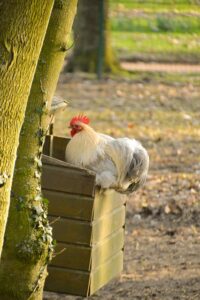If you’re into keeping chickens, sustainable farming, or just want to keep your lawn naturally trimmed and fertilized, you’ve probably heard of chicken tractors. They’re the Swiss Army knife of the poultry world and, no—the name isn’t as confusing as it sounds. While you won’t see your hens driving a John Deere anytime soon, these mobile coops are a game-changer for anyone raising chickens, whether you’re a seasoned farmer or just starting your backyard flock. Let’s dig in!
I. Understanding Chicken Tractors
What Are Chicken Tractors?
Imagine a tiny, movable house for your chickens that doubles as a yard-keeping, soil-enriching, egg-laying marvel. That’s a chicken tractor. These coops are lightweight, portable, and open-bottomed, allowing your feathered friends to peck and fertilize your garden as you move them around. Think free landscaping AND breakfast.
History and Evolution
The idea isn’t new. Farmers have used mobile chicken housing for centuries to optimize grazing, protect their livestock, and improve soil. But modern chicken tractors? They’re designed with practicality and sustainability in mind.
Benefits and Limitations
Benefits:
- Fresh grazing areas daily = happy chickens and fresh eggs!
- Fertilizes your yard naturally (a gardener’s dream).
- Keeps chickens safe from predators.
Limitations:
- They’re mobile but require a bit of muscle to move around.
- Not ideal for too many birds—it’s no chicken mansion.
Different Types of Chicken Tractors
There are A-frames, hoop houses, and even DIY contraptions that defy all chicken coop logic. The type you choose depends on your flock size, climate, and personal aesthetic preference (because who doesn’t love a stylish chicken coop?).
II. Planning Your Chicken Tractor
A. Size Considerations
Number of Birds: Each bird needs around 8-10 square feet of space for mental and physical well-being. (Trust me, cramped birds are grumpy.)
Available Space: Got a backyard or a field? Perfect.
Moving Capacity: Ensure the structure is light enough to move but heavy enough to withstand wind gusts.
Height Requirements: Chickens love to stretch and flap. Give them enough headroom.
B. Location Planning
- Terrain Assessment: Avoid slopes unless you want your chickens accidentally learning parkour.
- Rotation Patterns: Rotate the tractor to prevent overgrazing (and bald patches in your yard).
- Seasonal Considerations: Shade in summer, sunlight in winter. Keep them comfy!
- Access Requirements: Ensure you can easily collect eggs and clean the tractor without resorting to chicken yoga.
III. Chicken Tractor Design Elements
A. Essential Components
- Frame Structure: Sturdy but lightweight—PVC, wood, or aluminum.
- Roofing Systems: Keep the rain out and the chickens dry.
- Flooring Options: Open bottoms are great for grazing, but a removable mesh floor can help in predator-heavy areas.
- Nesting Areas & Roosting Bars: A cozy nest is a productive nest. Roost bars? More sleep, fewer squabbles.
- Feed and Water Stations: Keep things steady to avoid chicken spillages (they’re messier than toddlers!).
B. Mobility Features
- Wheel Systems: Large enough to roll over rough terrain.
- Handle Designs: Make sure it’s easy to grab and maneuver.
- Weight Distribution: Prevent tipping—your chickens will thank you.
- Moving Mechanisms: Some fancy ones even have pulleys or motors… because why not?
IV. Building Your Chicken Tractor
A. Material Selection
- Wood Options: Sturdy but prone to rot—treat it!
- Metal Components: Durable and rust-proof options are a win.
- PVC Alternatives: Lightweight and easy to move.
- Predator-Proof Materials: Wire mesh is your best friend. Foxes? Not so much.
B. Construction Steps
- Build the frame—think of it as your chicken tractor skeleton.
- Add walls and roof for comfort and safety.
- Attach wheels for mobility (or ski options if winter’s a thing for you).
- Set up your nesting and roosting areas.
- Feel smug about your carpentry skills and take a bow.
You’ll want to make sure it’s light enough to pull. You can use wheels or a more sled design. You’ll find many designs on the internet.
V. Managing Your Chicken Tractor System
A. Daily Operations
- Moving Schedule: Fresh grass every day = happy hens.
- Feeding Routines: Chickens are early risers. Be ready before they get hangry.
- Water Management: Hydration is key, especially in summer.
- Egg Collection: Nothing beats the joy of gathering fresh eggs!
- Health Monitoring: Check for signs of illness or injury. Your chickens deserve the VIP treatment.
B. Maintenance Tasks
- Structural Checks: Inspect for wear and tear.
- Cleaning Procedures: No one likes a dirty house, and your chickens are no exception.
- Seasonal Adjustments: Modify ventilation, insulation, and shade as needed.
VI. Seasonal Management
- Summer Operations: Maximize shade and ventilation. Heatstroke is a no-go.
- Winter Adaptations: Insulated walls and straw bedding will keep them cozy.
VII. Chicken Tractor Integration
A. Garden Systems
Chickens = natural pest control and fertilizers. Rotate their tractor around your garden for crop rotation and enriched soil.
B. Permaculture Applications
They’re not just cute feathered friends—they’re a crucial part of any sustainable permaculture system. Chickens help regenerate land and boost biodiversity.
VIII. Common Chicken Tractor Challenges
A. Physical Issues
Moving problems or predator attacks? Reinforce and reevaluate your design.
B. Management Issues
Too many birds or not enough space? Find that Goldilocks sweet spot.
IX. Economics of Chicken Tractors
A. Cost Analysis
Sure, there’s an upfront investment, but over time, the fresh eggs, pest control, and soil fertility more than pay for themselves.
X. Advanced Chicken Tractor Systems
From automated options to commercial setups, there’s a growing wave of innovation for large-scale farms.
XI. Future of Chicken Tractors
New materials, smarter designs, and emerging technologies are pushing the humble chicken tractor into the future. Who knows—robot-powered chicken tractors might be next!
Why Chicken Tractors Are a Must
These mobile coops are more than just a farming tool—they’re an all-in-one system for anyone looking to raise happy chickens while practicing sustainable living. Have you been on the fence about getting chickens? A chicken tractor just might be the boost you need to start your flock.
Got questions about building your own chicken tractor or managing one effectively? Drop them in the comments below! We’d love to help you get started on this clucking fabulous adventure. 🐔

